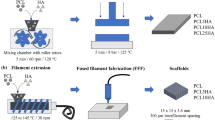Abstract
Osteoconductive ceramic implants based on Ca3–x M2x (PO4)2 (M = Na, K) double phosphates and having the Kelvin structure, tailored macropore size (in the range 50–750 μm), and a total porosity of 70–80% have been produced by stereolithographic 3D printing. We demonstrate that, to maintain the initial geometry of a model and reach sufficiently high strength characteristics of macroporous ceramics (compressive strength up to 9 MPa and fracture toughness up to 0.7 MPa m1/2), the polymer component should be removed under specially tailored heat treatment conditions. Based on our results on polymer matrix destruction kinetics, we have found heat treatment conditions that ensure a polymer removal rate no higher than 0.1 wt%/min and allow one to avoid implant cracking during the firing process.
Similar content being viewed by others
References
Ievlev, V.M., Putlyaev, V.I., Safronova, T.V., and Evdokimov, P.V., Additive technologies for making highly permeable inorganic materials with tailored morphological architectonics for medicine, Inorg. Mater., 2015, vol. 51, no. 13, pp. 1295–1313.
Dorozhkin, S.V. and Epple, M., Biological and medical significance of calcium phosphates, Angew. Chem., Int. Ed., 2002, vol. 41, no. 17, pp. 3130–3146.
Bohner, M., Physical and chemical aspects of calcium phosphates used in spinal surgery, Eur. Spine J., 2001, vol. 10, pp. 114–121.
Barinov, S.M., Calcium phosphate-based ceramic and composite materials for medical applications, Usp. Khim., 2010, vol. 79, no. 1, pp. 15–32.
LeGeros, R.Z., Lin, S., Rohanizadeh, R., Mijares, D., et al., Biphasic calcium phosphate bioceramics: preparation, properties and applications, J. Mater. Sci.–Mater. Med., 2003, vol. 14, no. 3, pp. 201–209.
Safronova, T.V. and Putlyaev, V.I., Medical inorganic materials research in Russia: calcium phosphate materials, Nanosist.: Fiz., Khim., Mat., 2013, vol. 4, no. 1, pp. 24–47.
Znamierowska, T., Uklad Ca3(PO4)2–CaKPO4–CaNaPO4, Zesz. Nauk. Politech. Slask. Ser.: Chem., 1982, vol. 709 [100], pp. 35–56.
Evdokimov, P.V., Putlyaev, V.I., Ivanov, V.K., Garshev, A.V., Shatalova, T.B., Orlov, N.K., Klimashina, E.S., and Safronova, T.V., Phase equilibria in the tricalcium phosphate–mixed calcium sodium (potassium) phosphate systems, Russ. J. Inorg. Chem., 2014, vol. 59, no. 11, pp. 1219–1227.
Evdokimov, P.V., Synthesis of Ca3–x M2x (PO4)2 (M = Na, K) double phosphates for macroporous bioceramics with specialized architectures, Cand. Sci. (Chem.) Dissertation, Moscow: Moscow State Univ., 2015.
Hing, K.A., Bioceramic bone graft substitutes: influence of porosity and chemistry, Int. J. Appl. Ceram. Technol., 2005, vol. 2, no. 3, pp. 184–199.
Klawitter, J.J., Bagwell, J.G., Weinstein, A.M., and Sauer, B.W., An evaluation of bone growth into porous high density polyethylene, J. Biomed. Mater. Res., 1976, vol. 10, no. 2, pp. 311–323.
Eggli, P.S., Mueller, W., and Schenk, R.K., Porous hydroxyapatite and tricalcium phosphate cylinders with two different pore size ranges implanted in the cancellous bone of rabbits, Clin. Orth. Rel. Res., 1988, vol. 232, pp. 127–137.
Lord Kelvin (Thomson, W.), On the division of space with minimum partitional area, Phil. Mag., Ser. 5, 1887, vol. 24, no. 151, pp. 503–514. doi 10.1080/14786448708628135
Zocca, A., Colombo, P., Gomes, C.M., and Günster, J., Additive manufacturing of ceramics: issues, potentialities, and opportunities, J. Am. Ceram. Soc., 2015, vol. 98, no. 7, pp. 1983–2001.
Evdokimov, P.V., Putlyaev, V.I., Ievlev, V.M., et al., Osteoconductive ceramics with a specified system of interconnected pores based on double calcium alkali metal phosphates, Dokl. Chem., 2015, vol. 460, no. 2, pp. 61–65.
Evans, A.G. and Charles, E.A., Fracture toughness determinations by indentation, J. Am. Ceram. Soc., 1976, vol. 59, nos. 7–8, pp. 371–372.
Putlyaev, V.I., Evdokimov, P.V., Garshev, A.V., et al., Strength characteristics of resorbable osteoconductive ceramics based on calcium alkali metal double phosphates, Izv. Vyssh. Uchebn. Zaved., Fiz., 2013, vol. 56, no. 10, pp. 72–77.
Author information
Authors and Affiliations
Corresponding author
Additional information
Original Russian Text © V.I. Putlyaev, P.V. Evdokimov, T.V. Safronova, E.S. Klimashina, N.K. Orlov, 2017, published in Neorganicheskie Materialy, 2017, Vol. 53, No. 5, pp. 534–541.
Rights and permissions
About this article
Cite this article
Putlyaev, V.I., Evdokimov, P.V., Safronova, T.V. et al. Fabrication of osteoconductive Ca3–x M2x (PO4)2 (M = Na, K) calcium phosphate bioceramics by stereolithographic 3D printing. Inorg Mater 53, 529–535 (2017). https://doi.org/10.1134/S0020168517050168
Received:
Published:
Issue Date:
DOI: https://doi.org/10.1134/S0020168517050168




